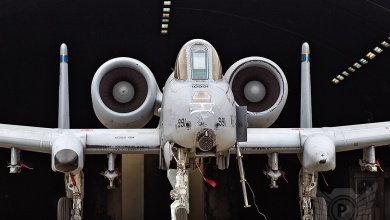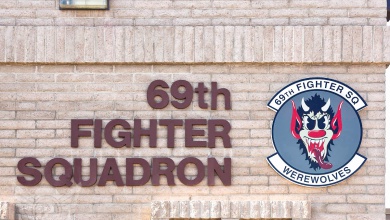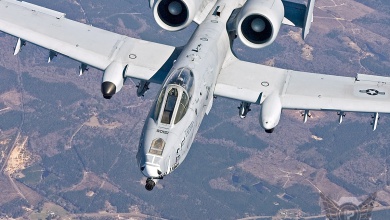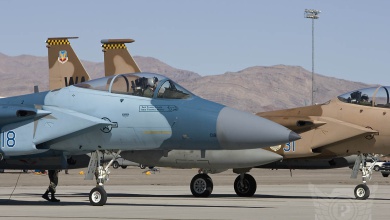It was March 10, 2014; a sunny Monday morning in Glendale, Arizona and a historic day for Luke Air Force Base (AFB). After several passes over the West Valley in formation with two F-16s, F-35A ‘AF-41′ touches down on runway 3R at 11:21 AM. A selective crowd of military personnel, family members and local media watches Col. Roderick Cregier, an Air Force test pilot, taxi this first F-35A for Luke’s 56th Fighter Wing in front of the Base Operations building. “Having the F-35 on the ramp here at Luke Air Force Base opens a new chapter in Luke’s history” says 56th Operations Group Commander Col. John Hanna in his speech after the F-35’s engine is shut down and the canopy has opened up frontwise.
Nearly three years of building the ‘Luke Forward’ campaign on getting the F-35 to the base has eventually contributed to a positive outcome of the F-35A Training Environmental Impact Statement (EIS) Report. On August 6, 2012 the U.S. Air Force (USAF) announced that Luke AFB will serve as the new primary F-35A training center for both U.S. and foreign pilots. In time Air Education & Training Command (AETC) will have six F-35A squadrons and a total of 144 aircraft based here.



Top Dogs reborn
The first squadron selected to transition to the F-35A at Luke AFB is the 61st Fighter Squadron (FS). While the history of these so-called ‘Top Dogs’ dates all the way back to World War II, in more recent years the 61st FS had already been based at Luke AFB as a F-16 training unit until disbanding on August 27, 2010. During an October 25 ceremony last year, the squadron was reactivated and Lt. Col. Michael Ebner introduced as the new squadron commander.
Upon arrival of the first F-35A, the squadron had four qualified F-35 pilots on staff and two more pilots 4 weeks in their conversion training with the 58th FS at Eglin AFB, Florida. “They are handling our initial training for the folks here until we stand up” Col. Ebner explains. He himself was actually stationed at Eglin AFB for three years where he was assigned to the 58th FS. Prior to that Col. Ebner was flying the F-15E Strike Eagle at Seymour Johnson AFB, NC. An initial message for future F-35 pilots came out and he decided to ‘put his name in the hat’ as he recalls it: “At the time I was the 4th Wing’s Weapons & Tactics Officer and actually met all these requirements and a lot of the desires for the F-35. Some of these requirements were a 1,000 hrs in a fighter aircraft, instructor qualified etc.”. He also met most of the desires such as being a Weapons School Graduate, having test experience and conformal training unit experience. By July 2010 he moved to Eglin AFB where he evolved from F-35A student pilot to a qualified F-35A instructor pilot and also acted as the Director of Operations for the 58th FS.


A total of 24 F-35s are assigned to each squadron and the 61st FS is scheduled to have received 16 of these aircraft by the end of this year. Once the squadrons is fully equipped, there will be an matching number of 24 pilots and around 300 people in staff and maintenance. Soon the Top Dogs will start flying although there will be some limitations at first according to Col. Ebner: “Currently we are restricted to Mach 0.9 until further testing”. Like many fighters the design limit for the F-35 is Mach 1.6 and currently test pilots at Edwards AFB are working on revised versions of the flight control software based on the behavior of the aircraft under all possible circumstances. “We will get that extended flight envelope as soon as the test pilots and engineers have seen that it is safe”.
From August 2012 the F-35 Integration Office at Luke AFB started working various construction projects as well as the Record Of Decision (ROD), environmental works and community relations. By now both the Aircraft Maintenance Unit (AMU) building and 61st FS Operations (OPS) building are completed and an existing nearby hangar has been refurbished to accommodate the new aircraft. Each F-35 squadron will eventually have its own OPS building containing 14 offices in the unclassified side plus eight briefing rooms and another eight offices in the vault area for pilot briefings.

The 145,000-square-foot Academic Training Center is still under construction and scheduled to open around August 2014. “It will be almost similar to the one at Eglin” Ebner clarifies “that one is build to house ten simulators, this one has the capacity to house twelve, so a little bit bigger on the pilot training side with some more classrooms. But the whole wing were they do the maintenance training for the Navy, Marine Corps and the Air Force, that is not a function that we are going to have here at Luke AFB”. The Academic Training Center is designed as a shared facility for all six squadrons and will initially have two simulators installed, gradually increased with the pace of squadrons being converted to the F-35.


Introduction to a historic event
This is a day that has been a long time coming and a result of many years of hard work by countless people in the military and in the community. Our mission here at Luke AFB is to train the world’s greatest fighter pilots and we have been doing this here for more than 7 decades. This jet right here behind us is the first of 144 F-35s that will be assigned here eventually at Luke AFB.
Col. John Hanna
F-35 Training Syllabus
Prior to starting any training courses, the 61st FS is currently in an ongoing process of beefing up its number of instructor pilots. Pilots that are selected will receive their conversion training with the 58th FS at Eglin AFB. Early March the first Luke AFB F-16 instructor pilot Capt. Arki completed his F-35 conversion course, joining the 61st FS as the fourth instructor pilot. In order to qualify for F-35 instructor pilot, one must meet certain requirements. “The syllabus requirements are spelled out by AETC and the amount of hours in the Block 1-B syllabus has a 750 hour requirement.” Col. Ebner explains “But to go through a transition course, a ‘TX course’, that will be determined by our ‘customers’ “. First in line will be pilots destined for developmental / operational flight test or the first active duty F-35 squadron to be based at Hill AFB, Utah. In those cases either Air Force Material Command (AFMC) or Air Combat Command (ACC) will work their selection processes and sets the initial requirements for pilots to enter the TX course. “However, the syllabus for the training is owned by our AETC which is responsible for signing off and officiating the syllabus” he concludes.
An interesting concept that instructor pilots are currently working on is customizing the syllabus to the background of each student. Pilots with a multi-role platform background such as an F-16 or F-15E will likely receive the ‘standard’ package during the course, but others might get additional training according to Col. Ebner: “If you came from like an A-10 and have limited Air-to-Air experience, then you are going to do the same syllabus, but we are going to do some additional training Air-to-Air. A couple of extra sorties and/or some extra sims and academics on Air-to-Air missiles and that sort of things. And likewise if you come from a platform like an F-15C with a pure air defense role, then we are going to give you an extra Air-to-Ground ride and learn about bombs, do some Close Air Support (CAS) rides in the syllabus to train that skill set. The idea is not to be exclusionary, because we know we are going to have pilots with all sorts of backgrounds and we have to accommodate that”.
Although some nuances in training might differ at each location, there is a lot of collaboration between Eglin and Luke according to Col. Ebner: “I think you will see the training to be very similar between the bases. We also develop our tactics volumes, techniques and procedures; we try to standardize these as much as we can Air Force wide and we have a ‘3-1’ and a ‘3-3’ which are our Tactics, Techniques and Procedures (TTPs), that tell us how to fly and employ. We all use those same documents. And there is dialogue with Eglin, we talk every day”. While waiting for more aircraft to arrive, all pilot also go back to Eglin every month to fly the F-35 there to stay current.

Pooling agreement
Under the Foreign Military Sales (FMS) program, both the Republic of Singapore and Taiwan have their own F-16 training squadron currently stationed at Luke AFB. Now that the base is selected as the primary F-35A training center, foreign participating countries in the Joint Strike Fighter (JSF) program will also sent aircraft and pilots here. Under the pooling implementation agreement both aircraft and pilots will be integrated in USAF fighter squadrons, rather than forming separate squadrons as with the current FMS squadrons.
The first partner country coming to Luke AFB will be the Royal Australian Air Force (RAAF). They will integrate into the 61st FS and their first aircraft are expected to arrive here later this year. The RAAF aircraft are manufactured from the same 6th Low Rate Initial Production (LRIP 6) Lot at Lockheed Martin’s production line as the Air Force F-35s delivered to the 61st FS. The pilots will be portioned to the amount of aircraft each country has within the squadron. “But as a U.S. pilot I can go fly an Australian jet and vice versa” Col. Ebner adds “That is part of the pooling agreement, a very complicated document in terms of legal matters and money. I cannot operate efficiently if I could only let fly an Australian pilot in an Australian jet. If their jets are in Phase or modification, you cannot stop their training”.
As a U.S. pilot I can go fly an Australian jet and vice versa. Lt. Col. Ebner

However, the maintenance piece will probably not be fully integrated because it is separated by the contracting from each country. The U.S. aircraft will be maintained by Air Force personnel, but at least some partner countries have plans to hire contractors instead. “Each country can do a cost analysis on what is cheaper; hire contractors or sent our own military over there” says Col. Ebner as he describes the complicated matters that his squadron has to deal with in making this work.
Other countries scheduled to integrate into future F-35 squadrons at Luke AFB by 2015 and up are Italy, Turkey, Norway and The Netherlands. As some aircraft purchases have not been finalized, more countries are expected to join in at a later stage. Once foreign pilots start arriving, they are all going to be trained to become instructor pilots at Luke AFB, as their first jets will all be there too. In time this will transform into more TX courses to build up pilots for the squadron abroad.

Viper changes
With Luke AFB being transformed into the primary F-35A training center, some changes needed to be made concerning the current F-16 training operations at the base. Therefore in time some of the F-16 training will relocate to Holloman AFB, New Mexico instead. On March 11, 2014, coincidently one day after the first F-35 arrived at Luke AFB, the 54th Fighter Group (FG) and three subordinate units were activated. The 54th FG is however just a tenant unit at Holloman AFB and in fact directly assigned to the 56th FW at Luke AFB.
Col. Rodney Petithomme assumed command over the 54th FG which is currently comprising the 54th Operations Support Squadron (OSS), 54th Aircraft Maintenance Unit (AMU) and reactivated 311th FS. The commander said that Holloman “will undoubtedly be a great fit for this new F-16 training mission, and we’re looking forward to a great partnership between the 49th Wing and the 54th FG” as quoted from his welcoming speech that day.
The 309th FS at Luke AFB will soon temporarily be deactivated awaiting future F-35 conversion. All personnel and F-16s will transfer to the 311th FS at Holloman over the next couple of months. Next year the 54th FG will reactivated a second F-16 Formal Training Unit (FTU), the 314th FS here as well. Upcoming April the 49th Wing at Holloman AFB no longer operates the F-22 Raptor; by then all aircraft have relocated to Tyndall AFB, Florida. The arrival of two new F-16 squadrons seems like a welcome compensation.
Plans are to maintain two USAF and two FMS F-16 training squadrons at Luke AFB. The 56th OG Commander Col. John Hanna adds “We expect that one of those U.S. squadrons will probably send those airplanes to the boneyard in about the 2020 timeframe. These are the oldest US F-16 that we fly here, the Block 25 in the 62nd FS currently. Then during the course of the seven years beyond that, well into the 20s, we will start sending our Block 42 aircraft to the boneyard. So we got a while!”.


Walking pace
With the arrival of the first F-35A, Luke AFB is one step closer in becoming the world’s largest F-35 base, but has yet a long way to go. The ground parameters are all there; space and funding (260 million) for support facilities, a dual parallel runway configuration, an extensive airspace, access to the Barry Goldwater Range and great flying weather. No wonder the USAF concluded that this base was the most suitable location for future F-35A training operations.
In the rush of modern technology and everyday life, the F-35 program might not meet the expectations of moving at a high tempo. But there is a continuous forward motion. “Not on a running pace, but more on a walking pace” as Col. Ebner puts it. This will be the main tactical fighter for the next 50+ years and so far this program is unprecedented on many levels. Looking at the total amount of flight hours accumulated by all three variants, the F-35 already has reached a safety record according to Ebner “Still not having lost a single aircraft is a huge testament to the aircraft. When you think about the F-35, this is like a half century program and we are at the very beginning”. The 61st FS will now lead the way in instructing the world’s finest F-35A aviators in an unmatched international training program.
Command structure
56th Fighter Wing [AETC] – Luke AFB, Arizona
56th Operations Group
| squadron | type | nickname | code | function | note |
| 21st FS | F-16A/B Block 20 | ‘Gamblers’ | LF | F-16 FTU | Taiwan AF (ROCAF) training |
| 61st FS | F-35A | ‘Top Dogs’ | LF | F-35 FTU | |
| 62nd FS | F-16C/D Block 25 | ‘Spikes’ | LF | F-16 FTU | converting to F-35A FY2015 |
| 63nd FS | ‘Panthers’ | LF | deactivated 2009 – to be reactivated FY2016 as F-35A FTU | ||
| 308th FS | F-16C/D Block 42 | ‘Emerald Knights’ | LF | F-16 FTU | converting to F-35A FY2018 |
| 309th FS | F-16C/D Block 42 | ‘Wild Ducks’ | LF | F-16 FTU | will deactivate until converting to the F-35A |
| 310th FS | F-16C/D Block 42 | ‘Top Hats’ | LF | F-16 FTU | |
| 425th FS | F-16C/D Block 52 | ‘Black Widows’ | LF | F-16 FTU | Republic of Singapore AF training |
56th Fighter Wing [AETC] – Luke AFB, Arizona
54th Fighter Group (GSU) – Holloman AFB, New Mexico
| squadron | type | nickname | code | function | note |
| 311th FS | F-16C/D Block 42 | ‘Winders’ | LF | F-16 FTU | |
| 314th FS | F-16C/D Block 42 | ‘Warhawks’ | LF | F-16 FTU | to be activated FY2015 |

Acknowledgement
Phodocu would like to thank 61st Fighter Squadron Commander Lt. Col. Michael Ebner, Chief Media Relations 1st Lt. Candice Dillitte and everyone else at 56th Fighter Wing Public Affairs Office for their effort and support.




